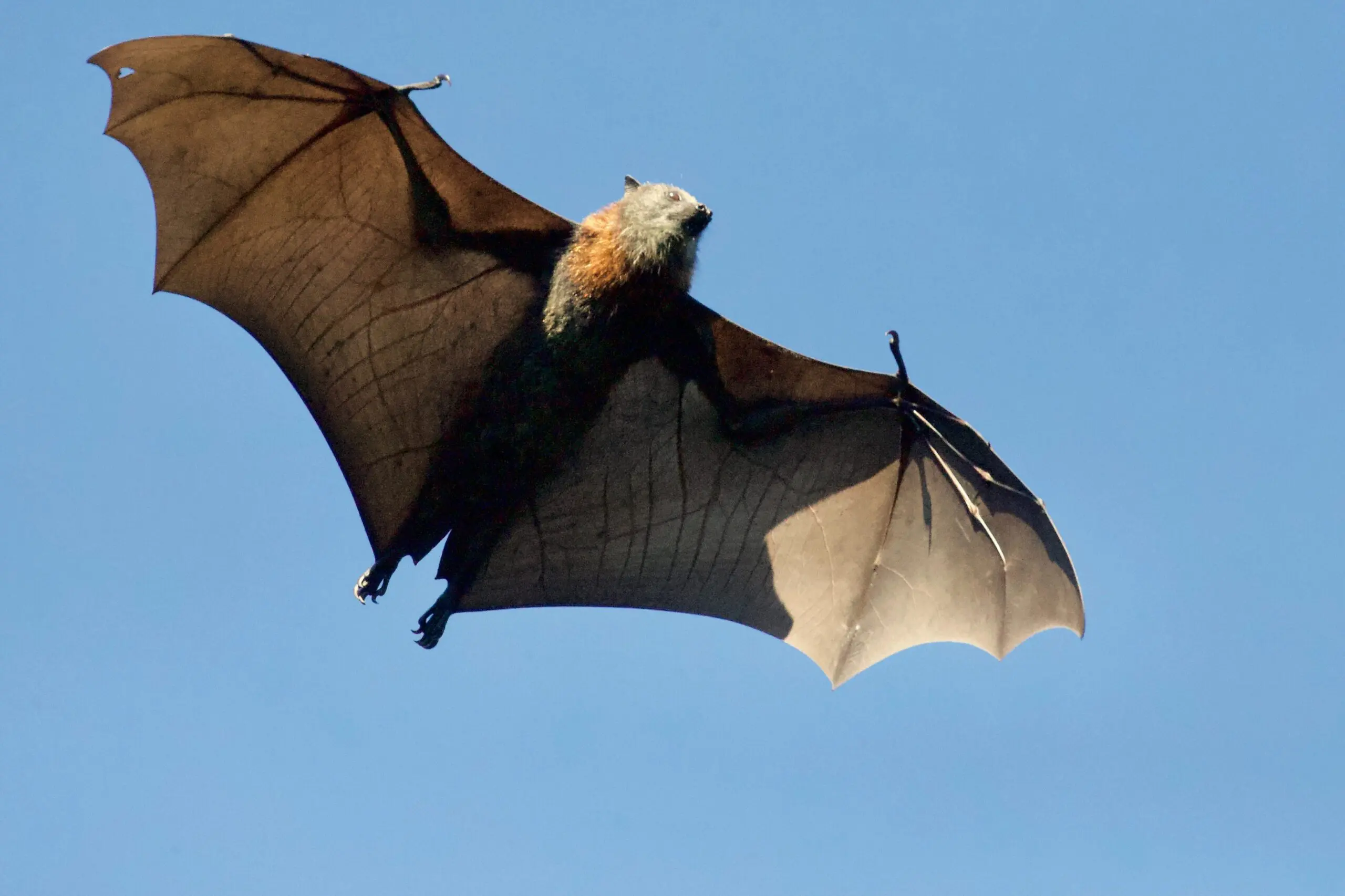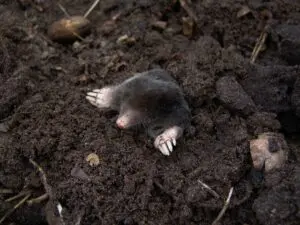

We all know bats as the Halloween mascot that can be seen flitting about in the evenings, but in reality, there is much more to them than that. Read on to learn just how unique bats really are.
1. There are thousands of bat species
To be more precise, there are over 1,400 species. Incredibly, bats can be found on every continent except for Antarctica! Bats range dramatically in size from one species to the next. The Kitti’s hog-nosed bat, also known as the bumblebee bat, weighs less than half of a penny and only grows to about 1.1 to 1.3 inches long. It is the smallest species of bat as well as one of the smallest mammals in the world. On the other end of the spectrum is the flying fox bat, which has a wingspan of up to 6 feet!
Flying‑fox fun facts
Flying foxes, also called fruit bats, are among the largest bats on Earth. The Malayan flying fox has a wingspan of up to 1.8 m (6 ft) and weighs roughly 1 kg, while the grey‑headed flying fox weighs about 300 grams and migrates up to 1 000 km along Australia’s east coast. These bats feed mainly on fruit, nectar and pollen, using long tongues to extract nectar and transfer pollen between flowers. Roosting camps can contain thousands of individuals and may be used for hundreds of years. Unlike many smaller bats, flying foxes do not echolocate; they rely on keen eyesight. At night they travel 30 km or more in search of food, and their long lifespans, up to 20–30 years, make them important seed dispersers and pollinators across forest ecosystems.
2. Bats are the only mammals that can fly
You may be wondering “what about flying squirrels?” Well technically, flying squirrels can’t actually fly- they glide through the air for short distances. Bats on the other hand can truly fly, and pretty quickly too. Bats can fly at speeds of more than 60 mph. One species, the Mexican free-tailed bat, can even fly up to 100 mph! They are the fastest mammals in the world by a longshot.
3. Some bats hibernate, some migrate, and some do both
Bats are well-known hibernators, but did you know that they are also prolific migrators? During the time that certain bats are settling into their local winter homes, others are migrating. Some species migrate to a warmer climate to avoid hibernating all together. Others migrate to a new location for hibernating.
4. Bats are pollinators
In fact, there are hundreds of types of fruits and plants that depend on bats for their pollination. Without bats, we would no longer have agave, avocados, bananas, mangoes, or saguaro cacti, just to name a few. Bats also spread the seeds of foods like cacao, figs, and nuts.
5. Bats are great for pest control
Beyond being responsible for the survival of hundreds of fruits through pollination, bats also defend crops through their eating habits. Bats typically eat their body weight in bugs each night, with some species eating as many as 6,000 in an hour! Some people even build bat houses to keep the insect populations in check in their yards and gardens.
6. Some bats drink blood
It’s true! The aptly named vampire bats do in fact drink blood, usually from sleeping animals like cows, horses, pigs, and birds. They make small cuts in their victims with their sharp teeth, and then use their tongues to lap up the blood. Their saliva contains an anticoagulant, so the blood does not clot and continues to flow. They can feed for as long as 30 minutes without waking their host up, and the feeding does not hurt the host. Vampire bats hunt by sensing the sound of their prey’s breathing. They can memorize the sound and return to the same host night after night.
What do bats do at night?
Bats are nocturnal, leaving their roosts at dusk and returning at dawn. Insect‑eating bats can consume thousands of mosquitoes and moths in a single night; a colony of 150 bats may eat 33 million insects over a summerskedaddlewildlife.com. Fruit‑eating species like flying foxes travel long distances to feed on figs, mangoes, bananas and nectar. Their nightly foraging provides pest control, fertilizes soils (bat guano nurtures microorganisms) and pollinates crops such as bananas, cashews, figs, dates and mangosskedaddlewildlife.com. Some bats even sip nectar while hovering, a behavior that helps pollinate cacti and agave plants. Understanding bats’ nocturnal lifestyle underscores why they are keystone species in many ecosystems.
7. Bats are important to medicine
Believe it or not, bats play a rather significant role in modern medicine. By studying the anticoagulant in the saliva of vampire bats, scientists have been able to develop drugs to combat both cardiovascular disease and arteriosclerosis. Studying bats’ use of echolocation has helped researchers develop better navigational aids for the blind. Advances in vaccines have also been achieved due to research done on bats. What’s more, there are around 80 medicines that are made from plants that rely completely on bats for their survival.
8. Bats are designed to hang upside down
Everything about a bat’s anatomy is ideal for hanging upside down. They are equipped with one-way valves to prevent their blood from pooling in their heads. What’s more, their claws allow them to hang without actually having to use any energy to hold on. Believe it or not, bats’ talons relax into a closed position and tighten around the perch based on the bat’s body weight pulling downward. So, in order to hang onto something, they simply have to open their claws, place them around their perch, and the gravity does the rest of the work. Bats hang upside down for a couple of reasons, but mainly because predators cannot easily reach them when they are hanging on the ceiling. In addition, there are virtually no other animals competing for ceiling real estate. Bats also need to drop from high up in order to start flying, as they cannot run or jump to get liftoff.
9. Are bats blind?
In reality, bats are not blind. Their eyes are small but highly sensitive, allowing them to see in light levels we would call pitch black. Megabats such as flying foxes have large eyes and rely mainly on vision, whereas many microbats use echolocation to find prey in total darkness but still see well enough to orient when it’s not completely dark. Some species can even detect ultraviolet light. The expression “blind as a bat” persists because people often observe bats emitting high‑pitched sounds while flying; these calls are part of echolocation, not an indicator of poor eyesight. Understanding that bats combine sight and sound to navigate and hunt helps dispel this common myth.
10. Disease is a bat’s biggest threat
Of the 40 species of bats in the United States, 10 species are endangered, 2 are threatened and even more than that are on a severe decline population-wise. This is mainly due to disease. Of course, bats have natural predators such as hawks, owls and snakes, but the effect of these predators on bat populations is small compared to the effect of disease. Perhaps the biggest threat to bats is white-nose syndrome, which is a fungal disease that affects hibernating bats. The disease has killed more than 90% of the populations of little brown bats, northern long-eared bats, and tri-colored bats in under 10 years. It is named for the fungus that grows around the muzzle and wings.
Myths about bats
• Bats get tangled in your hair: False. Bats are agile fliers chasing insects. They rarely collide with people and almost never become entangled.
• All bats carry rabies: False. Fewer than 1 % of bats contract. Caution is still warranted with grounded or sick bats.
• Bats drink human blood: False. Only three species of vampire bats feed on blood, usually from livestock. They make a small cut and lap the blood; they seldom bite .
• Bats are flying mice: False. Bats belong to their own order, Chiroptera; they are not rodents and are more closely related to primates than to .
• Without bats there would be no tequila: True! Certain agave plants rely on bats for pollination, so the tequila industry depends on healthy bat populations.
These myth‑busters, taken together with the fact that bats have excellent vision, show why bats deserve respect rather than fear.
Bat anatomy 101
Bats’ ability to fly comes from a unique body plan. Their forelimbs are modified for flight—the arm and four fingers are elongated to support a thin membrane of skin that contains blood vessels, nerves and tendons. The thumb remains free, tipped with a claw that aids in climbing and handling food. Behind the wings is the uropatagium, a membrane stretching between the hind legs (supported by the tail or small calcars) that acts like a pouch to help catch insects in flight. Bats also have slender hind limbs with backward‑facing knees and long toes ending in sharp claws; one‑way valves in their veins allow them to hang upside‑down without blood pooling in the head. Many species sport large mobile ears and, in some families, a nose leaf that helps direct echolocation calls. This intricate anatomy makes bats the only mammals capable of powered flight.
How can we help bats?
It is important that we do our part to slow the spread of diseases like white-nose syndrome. Try to avoid areas where bats might be hibernating, and if you do visit such an area, decontaminate your clothes, shoes, and gear before entering the area. Bats are also suffering loss of habitat, making bat houses a great way to help out your local population. Together, we can work towards taking bats off of the endangered list altogether, one step at a time.






